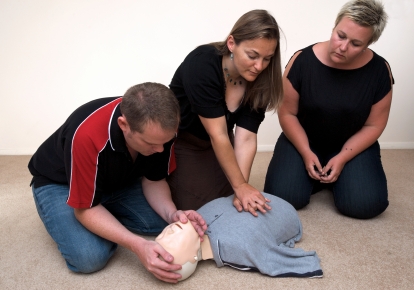Training
Injury & Illness Prevention Program Training • Hazard Communication Training • Lockout/Blockout Training
Forklift Training • CPR/AED & First Aid • Bloodborne Pathogens Training • Ergonomic Training • Lifting Techniques

Injury & Illness Prevention Program Training: Companies with more than 10 employees are required to have an Injury & Illness Prevention Program (IIPP) in the state of California. It is further required that all employees receive training on the IIPP. The components of an IIPP that require employee training include having:
- an individual in charge of the program from within the company
- an inspection program in place to identify, evaluate, and eliminate workplace hazards
- methods to correct unsafe or unhealthy conditions in a timely manner
- a safety training program for employees
- a means to communicate with employees about health and safety matters
- a way to enforce and/or discipline employees for the violation of safety rules
- a record keeping system regarding training and medical surveillance
Hazard Communication Training: All employees who work with hazardous materials must have hazard communication training. This training is also known as “The Right to Know” law and requires that employees know where/how to find information on the chemicals (hazardous materials) they are working with. The most common method for obtaining that information is with the Material Safety Data Sheet (MSDS). It is required under Title 8 of the California Code of Regulations that all manufacturers of hazardous materials provide companies with an MSDS(s) for that hazardous material(s). The MSDS has pertinent information related to the physical characteristics of the hazardous material along with first aid information regarding to what to do if you are exposed. MSDS binders for workplace hazardous materials must be kept in an area where workers have access to such information.
Labeling requirements are also a major part of the Hazard Communication Program. Primary and secondary labeling requirements are discussed during training so that employees have an understanding about how hazardous materials should be labeled. Storage of hazardous materials is also a very important part of this training. The compatibility (e.g., acids & bases) of different hazardous materials is very important when storing chemicals together.
Lockout/Blockout Training: Training for the LO/BO program requires that employees and/or contractors be restricted from using the equipment being maintained. A system must be instituted that includes a LO/BO log, which must be maintained, and one set of keys issued to the employee/contractor performing the maintenance on the equipment. Appropriate locks and/or blocks must be used for the equipment being locked or blocked out. EHSConsult can provide customized training to help companies develop and implement a comprehensive LO/BO program that meets with the Cal/OSHA standards.
Forklift Training: A comprehensive forklift and/or industrial truck training program is offered to clients based on the Ives Training Program. EHSConsult certified trainers have gone through an extensive “Train the Trainer” program which incorporates all of the Cal/OSHA regulatory requirements into the training. The training includes both hands-on and classroom instruction along with two follow-up quizzes. We also offer a “Train the Trainer” program for clients who wish to implement their own training program with an in-house certified trainer.
 CPR/AED & First Aid Training: Based on Red Cross curriculum, EHSConsult certified trainers offer an all inclusive training class in CPR/AED and First Aid. The class is designed so that employees feel confident in the event that a medical emergency occurs at the workplace. Specific training includes instruction on the number of chest compressions and rescue breaths needed if one suspects a heart attack or if the victim is not breathing. Employees are also trained on how/when to contact emergency medical professionals should they find themselves in an emergency situation. Automatic External Defibrillators (AED) are also used frequently in workplaces as well as among the general public these days. AEDs are very user friendly life saving devices, but in order to feel comfortable using them, it is suggested that employees go through a basic First Aid and CPR training class. AEDs need to be registered with the county and signed off by the medical director (workers’ comp physician) for the company using such devices. For additional information on AEDs please contact us as we work directly with Cardiac Science as a distributor on the central coast.
CPR/AED & First Aid Training: Based on Red Cross curriculum, EHSConsult certified trainers offer an all inclusive training class in CPR/AED and First Aid. The class is designed so that employees feel confident in the event that a medical emergency occurs at the workplace. Specific training includes instruction on the number of chest compressions and rescue breaths needed if one suspects a heart attack or if the victim is not breathing. Employees are also trained on how/when to contact emergency medical professionals should they find themselves in an emergency situation. Automatic External Defibrillators (AED) are also used frequently in workplaces as well as among the general public these days. AEDs are very user friendly life saving devices, but in order to feel comfortable using them, it is suggested that employees go through a basic First Aid and CPR training class. AEDs need to be registered with the county and signed off by the medical director (workers’ comp physician) for the company using such devices. For additional information on AEDs please contact us as we work directly with Cardiac Science as a distributor on the central coast.
Bloodborne Pathogens Training: It is important to have employees who are at risk of exposure to bodily fluids be trained on Bloodborne Pathogens (BBP). Universal precautions (e.g., gloves, face masks, face shields, goggles, gowns, etc.) along with engineering controls are taught during this training for employees and management in an effort to help reduce potential exposures. A HBV vaccination program is also discussed with company management at the time of this training.
Ergonomic Training: A basic ergonomic training program is provided for all employees. The training is customized to accommodate the specific needs of the business. Examples of this training include desk, chair, and computer work center design. There are also specific exercises that can be incorporated into work schedules in an effort to help employees relieve stress to certain areas of their bodies. A lot of this training is very basic and does not take much time to fit in to their daily routine. Reporting ergonomic injuries is an important part of ergonomic training. Unreported ergonomic injuries cost companies exponentially more money than reporting them early. Workers’ Compensation claims have skyrocketed in recent years due to ergonomic injuries. Some of those claims could have been avoided with a relatively inexpensive change to a job function or the incorporation of a specialized exercise routine.
Lifting Techniques: Employees who are expected to lift items as part of their jobs should have training on how to lift properly. This training can be customized for employers so that it addresses the specific areas of their businesses where lifting is part of an employee’s job. The training emphasizes how to lift using one’s legs rather than their backs. It also includes proper body stances when lifting items, as well as when items are too heavy to lift alone and help from others should be requested.